Climate
-
Temperature
15-30°C -
Rainfall
400-500mm -
Sowing Temperature
15-20°C -
Harvesting Temperature
25-30°C
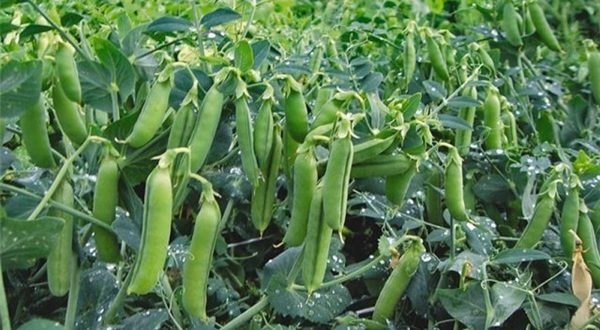
















It can grow on various soil types from sandy loam to clay soils. It gives best results when grown under well drained soil with pH range of 6 to 7.5. Crop cannot withstand in water logging conditions. For acidic soil, do liming.
T 163 (1978): Suitable for grains. The variety gets mature in 150 days and gives an average yield of 6-8 qtl/acre.
RPG 3 (1982): Suitable for grains. The variety gets mature in 125 days and gives an average yield of 8-10 qtl/acre. It gives 20-22% more yield than T 163 variety. Wide legume variety. The variety is resistant to root rot and pod borer.
Rachna (1987): The variety gets ready in 135-140 days and gives an average yield of 12-15 qtl/acre.
DMR (1996): This has 105-110cm plant height. The variety gets ready in 130-135 days and gives an average yield of 8-10qtl/acre.
Other state varieties:
PG 3: Dwarf and early maturing variety, ready to harvest in 135 days. Flowers are of white color and grains are of creamy white color. It is having good cooking quality. As it is early maturity variety attacked of powdery mildew and pod borer is less.
Punjab 88: Early season variety developed by PAU, Ludhiana. Pods are dark green and curved. Ready to harvest in 100 days. It gives green pod yield of 62 qtl/acre.
MatarAgeta 6: Early season dwarf variety developed by PAU, Ludhiana. Seeds are smooth and of green color. It gives yield of 24 qtl/acre.
Field Pea 48: It is an early maturing and semi dwarf variety. Ready to harvest in 135 days. Seeds are of light green color, bold, slightly wrinkled. It has good cooking quality. It gives average yield of 27 qtl/acre.
Early season varieties:
Asauji: Developed at IARI.
Early Superb: Dwarf variety from England.
Arkel: Variety from France. Gives yield of 18-20 qtl/acre.
Little Marvel: Dwarf variety from England.
Alaska
JawaharMatar 3: Gives average yield of 16 qtl/acre.
JawaharMatar 4: Gives average yield of 28 qtl/acre.
Pant Matar
Hissar Harit
Punjab 89
Mid-season varieties:
Bonneville: Variety from USA. Gives average yield of 36 qtl/acre.
Alderman, Perfection New line, T 19
Lincon: Gives average yield of 40 qtl/acre.
Jawahar Matar 1: Gives average yield of 48 qtl/acre.
Jawahar Matar 2
Pant Uphar : Gives average yield of 40 qtl/acre.
Ooty 1: Gives average yield of 48 qtl/acre.
Jawahar Pea 83: Gives average pod yield of 48-52 qtl/acre.
Jawahar Peas 15: Gives average pod yield of 52 qtl/acre.
After kharif crop harvesting, to obtain fine seed bed do one to two ploughing. Along with ploughing take 2-3 harrowing and do planking after ploughing operation. Field should be level to avoid water logging conditions in soil. Give pre-sowing irrigation before sowing of crop, it will help in good germination of crop.
Time of sowing
To obtain good yield complete sowing between October end to Middle of November. Further delay in sowing will lead to yield loss. For early marketing, some grower sows peas in Second Fortnight of October.
Spacing
Use spacing of 30cmx5cm for early varieties and for late varieties use spacing of 45-60cm x 10cm.
Sowing Depth
Sow the seeds at depth of 2-3cm in soil.
Method of sowing
For sowing use seed cum fertilizer drill on ridges which are 60 cm wide.
Seed Rate
For sowing one acre land use seed rate of 35-40 kg/acre.
Seed Treatment
Before sowing, treat the seed with Captan or Thiram@3gm/kg of seed or Carbendazim@2.5gm/kg of seed. After chemical treatment, treat seeds with Rhizobium leguminosarum culture for better quality and yield. The culture material is emulsified in 10 percent sugar solution or jaggery solution. Mix thoroughly the emulsified culture with seed and dry in shade. It will increase yield upto 8-10%.
Use any one of the fungicides:
| Fungicide name | Quantity (Dosage per kg seed) |
| Captan | 3gm |
| Thiram | 3gm |
| Carbendazim | 2.5gm |
Fertilizer Requirement (kg/acre)
| UREA | SSP |
MOP |
| 25 | 120 | On soil test results |
Nutrient Requirement (kg/acre)
| NITROGEN | PHOSPHORUS | POTASH |
| 10 | 20 | # |
At time of sowing apply Nitrogen@10kg in form of Urea@25kg and Phosphorus@20kg in form of Superphosphate@120kg per acre. Drilled complete dose of fertilizer along the rows.
Pre sowing irrigation should be given for good germination. When it is cultivated after paddy crop and soil content sufficient moisture, it can sow without irrigation. After sowing it required two or three irrigation. Apply first irrigation during pre-flowering and second at pod formation stage. Heavy irrigation leads to the yellowing of plants and thus reducing the yield.
Depending upon variety it required one or two weeding. First weeding is done either at 2-3 leaves stage or 3-4 weeks after sowing and second weeding is done before flowering. Using herbicides is the effective method of controlling weeds in pea’s cultivation. Pendimethline@1lt/acre and Basalin@1ltr/acre give good results in controlling the weeds. Apply herbicides within 48 hours of sowing.
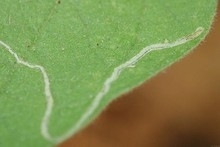
Pea leaf Miner: Larva of leaf miner creates tunnel in leaves. Due infestation loss of 10-15% is observed.
If infestation is observed, take spray of Dimethoate 30EC@300 ml in 100-150 Ltr water per acre. If necessary repeat the spray after 15 days.
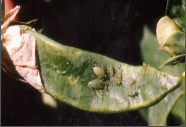
Pea Thrips and Aphid: They suck cell saps leads to yellowing of crop and thus decreases yield of crop.
If infestation is observed, take spray of Dimethoate 30EC@400 ml in 80-100 Ltr water per acre. If necessary repeat the spray after 15 days.
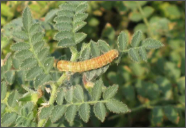
Pod borer: Pod borers are the most serious pests of pea. They bore flowers and pods, causing 10-90% losses, if left unprotected.
When infestation is in initial stage, take spray of Carbaryl@900gm/100Ltr of water per acre. If necessary repeat the spray after 15 days. In case of severe infestation take spray of Chlorpyriphos@1 Ltr or Acephate@800 gm in 100 Ltrs of water per acre with manually operated knapsack sprayer.
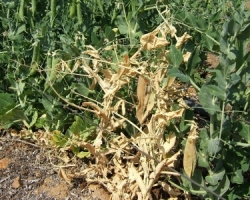
Wilt: The roots turn black and the later rot away. Plant growth is stunted and discoloured, foliage turn yellow and downward curling of stipules and leaflets take place. The entire plant wilts and stem shrivels.
Control measures: Treat seeds with Thiram@3gm/Ltr water or Carbendazim@2gm/Ltr water of water before sowing and avoid early sowing in badly affected areas. Follow three year crop rotation. Drench the infected area with Carbendazim@5gm/Ltr water. Destroy the weed hosts such as Lathyrus vicia etc.
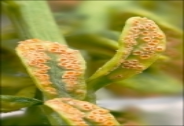
Rust: Yellowish, brown spherical pustules can be observed on stems, leaves, branch and pods.
Spray Mancozeb@25gm/10Ltr of water or Indofil Z-78@400gm/150Ltr of water on disease appearance and repeat the spray at 10-15 days intervals.
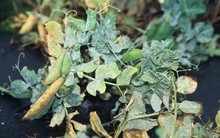
Powdery Mildew: Patchy, White powdery growth appears on lower side of leaves, branches and pods. It parasitizes the plant using it as a food source. It can develop at any stage of crop development. In severe infestation it causes defoliation.
If infestation is observed, take spray of Karathane 40EC@80 ml in 100 Ltr water per acre. Take three sprays of Karathane with interval of 10 days.
The green peas pods should be harvested at proper stage. Harvesting of peas may start as soon as peas started changing colour from dark to green. Multiple pickings like, 4 to 5 pickling can be done within the 6 to 10 days interval. Yield depends on the variety, soil fertility and management of the field.
Storage is done at low temperature to increase the availability of green pods for longer duration. packing is done in gunny bags, corrugated fibre board boxes, plastic containers and bamboo baskets.
It belongs to leguminosae family. It is a cool season crop grown throughout the world. Green pods are used for vegetable purpose and dried peas are used as pulses. In India it is cultivated in Himachal Pradesh, Madhya Pradesh, Rajasthan, Maharashtra, Punjab , Haryana, Karnataka and Bihar. It is rich source of proteins, amino acids and sugars. Green pea's straw is good source of nutritional fodder for livestock.
You have successfully login.
Your email and password is incorrect!